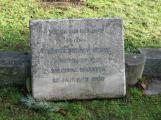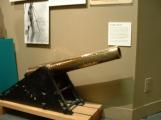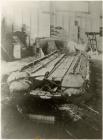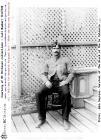14
The wreck of the S.S. Valencia at Cape Beale23 January 1906
West Coast of Vancouver Island, British Columbia, Canada
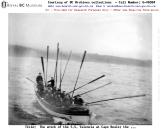
15
Call Number: G-06584Cat. Number: HP020784
Subject: ships-disasters
Geo. Region: Alberni-Clayquot
Title: The wreck of the S.S. Valencia at Cape Beale; the return of the lifeboat crew of the HMS Egeria.
Photographer: Crocker, Ernest william albert, 1877-1968
Date: 23 Jan 1906
Accession Number: 193501-001
The Hours after the Wreck
" I was in my bunk asleep. I got up at once and went on deck. It was thick dark, sleeting and blowing a stiff breeze. I could not see
any light. I went back and got my clothes. By that time the passengers were getting out of their rooms and most of them had life preservers on.
At the time the engines were working, but I don't know which way. The chief officer told me to clear away the boats, which I did.
The deck was crowded and it was so dark I could not tell the crew from passengers.
We only carried eight sailors and four quartermasters.
We had seven boats and three rafts. The davits were drop davits.
The captain shouted from the bridge to lower all boats to the saloon rail and keep them there, but the four forward boats were lowered all the way; most of them were full of passengers and there was a strain on the tackles. Of those four boats, only one, No. 2, got away from the ship's side. There was a heavy sea running, breaking almost to the bridge, and I am doubtful if those boats could have got away even in daylight.
The captain turned the searchlight all around. I saw No. 2 boat off at some little distance, then someone pulled the whistle and the electric lights went out.
I saw No. 1 boat smash alongside. There would be 15 or 20 people in her.
I had a ladder thrown over, also some ropes and I saw one man climb aboard.
At that time, the Valencia took a heavy list to port and No. 7 boat was lowered.
I saw the firemen's mess boy in No. 6 boat. She got away from the ship's side.
One raft was also put overboard. There were at the time several people in the rigging and the rest on the hurricane deck. Some rockets were then assuring the passengers that they would be all right. At the same time the social hall and the weather side of the saloon were the only dry places on the ship"
Boatswain T.J. McCarthy gives his account before the Coroner's jury in Victoria...as recorded on pg. 53 of The Unforgiving Coast by David H. Grover, Oregon State University Press
16
The wreck of the S.S. Valencia23 January 1906
West Coast of Vancouver Island, British Columbia, Canada
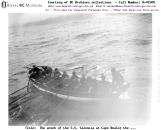
17
The catastrophe of the Valencia and some of the eventsJanuary, 1906
West Coast of Vancouver Island, British Columbia, Canada
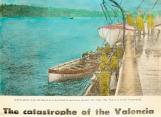
18
Photo courtesy of The Vancouver Maritime MuseumThis photo shows the Queen as a boatload of survivors reaches the ship.
Of the few boats that made it to shore that night, only a handful of survivors made it safely to shore.
Frank Bunker leads them to the lineman's cabin at Darling River and they summon help by tapping into the telephone wire.
Logan, Daykin and Martin begin their journey to the site.
At daylight on January 23rd, Captain Johnson orders that a line be shot ashore using the Lyle gun, but there is no one there to secure it.
Joe Segalos attempts to take a line ashore, but doesn't succeed. He is hauled back onboard ship.
Captain Johnson asks Boatswain McCarthy to lead a group in lifeboat No. 5.The group makes shore three miles from Cape Beale. They make their way to the lighthouse by nightfall and are amazed to find the news of the wreck has preceded them.
The Queen is the first ship to arrive on the scene, making her first approach Wednesday morning. Although she can see life aboard, she is unable to get close enough to assist.
The tug Czar and the steamer Salvor arrive, but they too, can give no assistance.
The City of Topeka, a sister ship of the Valencia's from the Pacific Coast Company arrives to relieve the Queen.
By noon on Wednesday, January 24th, the Logan party arrives on the scene of the tragedy. They locate the line that had been shot from the Lyle gun (Captain Johnson reportedly lost two of his fingers attempting to fire a line ashore), but it is worn through by this time. All they can do is watch helplessly during the Valencia victims final moments.
On January 25th the Orion, a whaling ship that had been working in the area gets in close enough to determine that all who had stayed with the ship are lost.
Later that day, the City of Topeka, retrieves 18 survivors from their lifeboat. Many of the crew, including the fireman Segalos are rescued.
One other liferaft makes shore at Turret Island in what is now The Broken Group Islands. Three survivors are located and brought to Toquart where they are retrieved by the SS Salvor, come to assist in the search for bodies. Another survivor of that liferaft, Connors, is later located after he wandered off. The rest of the occupants of the lifeboat reportedly went insane and/or drowned.
The retrieval of bodies continues for many weeks after.
This was compiled using many sources of information, including The Unforgiven Coast, by David Grove, Breakers Ahead by Bruce Scott, Great Shipwrecks of the Pacific Coast by Robert C. Belyk, Keepers of the Light by Donald Graham, various newspaper articles and periodicals.
20
Photo credit: Heather Cooper, Bamfield Community School AssociationThis photo is of a Lyle gun, of the type that was used to attempt a shore rescue by firing a light line to shore, which a shore party would then tie to a heavier line so the passengers could be brought ashore in a sling.
At daylight on January 23rd, 1906, Captain Johnson orders that a line be shot ashore using the Lyle gun, but there is no one there to secure it.
By noon on Wednesday, January 24th, the Logan party arrives on the scene of the tragedy. They locate the line that had been shot from the Lyle gun (Captain Johnson reportedly lost two of his fingers attempting to fire a line ashore), but it is worn through by this time.
All they can do is watch helplessly during the Valencia victims final moments.
22
Photo courtesy of The Vancouver Maritime MuseumValencia liferaft.
Date: Undetermined
The Issue of Tule Life Preservers
Pg. 9 "The uselessness of using rushes or hair was known and, with the then current technology, the choice lay between cork and air inflated belts. Cork was chosen because it is durable and not susceptible to puncture."
Pg. 10 "In 1857, the cork block type lifejacket was very much favoured by the U.S. Board of Supervising Inspectors of the Bureau of Marine Inspection and Navigation. The following quotation is extracted from an unpublished brief history of the US coast Guard: "while engaged in the consideration of cork block life preserver, your committee would state that recent disasters have established their efficiency and reliability. Life preservers of this material if properly made and having sufficient buoyancy, fully comply with the public. This opinion is, however, based upon the supposition that life preservers of this material are made in the form of a jacket, and the cork filling either in blocks or pieces."
DESIGNED FOR LIFE - LIFEJACKETS THROUGHOUT THE AGES
Dr. C. J. Brooks Copyright 1995 by Mustang Engineered Technical Apparel Corp. 3810 Jacombs Road, Richmond, British Columbia, Canada
V6V 1Y6 ISBN 0-9699913-0-4
NB pg 31 of the inquest in Don Graham's files, Tim McCarthy says, "some of them had cork jackets on them" in regards to the other men in the life raft with him.
In 1911, the Santa Rosa, another of the Pacific Coast Steamship Company's fleet hit the beach at Point Arguello. The company sent another vessel, the President to remove passengers.
"During the Santa Rosa's final hours, ship's officers advised the frightened passengers against putting on the lifejackets provided for their safety. 'They're filled with tule,' it was explained, 'and they won't float. We always buy our own cork jackets and keep them with us when we're working for Pacific Coast Steam.' Such were the Good Old Days aboard the Pacific Coastal Liners." Pacific Coast Liners All the Color and Stark Drama of the Ships that Steamed Offshore from Baja California to Nome by Gordon Newell & Joe Williamson 1959 by Bonanza Books.
23
Joe Cigalos, crew member of the SS ValenciaJanuary, 1906
West Coast of Vancouver Island, British Columbia, Canada

24
Joe Cigalos, (John Segalos), crew member of the SS Valencia and survivor.Photo courtesy the Vancover Maritime Museum
Many heroes emerged from the story of the Valencia. Here are but a few.
John Segalos (Joe Cigalos), a Greek fireman and crew member, risked his life several times to assist in saving lives. He is reported to have made at least one attempt at getting a line to shore by swimming with a line tied to his waist (he was hauled back on shore after half an hour in the frigid waters). He is also said to have assisted his fellow survivors after they were picked up from their life raft and taken aboard the City of Topeka , and to have returned to the scene the next day to assist. In this, Segalos was too late. The Valencia had sunk. The Seattle Board of Trade gave him a bronze medal. He was "favorably indorsed as one of the Carnegie hero fund beneficiaries." Pacific Monthly, March, 1906.
Other information gained from Bruce Scott's Breakers Ahead and newspaper accounts.
Bruce Scott, in Breakers Ahead tells us this story of Alfred Willis, a seventeen year-old sailor in the US Navy.
"The drain plug was found to be missing from the bottom of another boat, and it began to fill with water. An American sailor named Willis, on his way to Seattle to join the battleship Philadelphia, placed his hand over the hole and kept it there despite the cold and confusion of trying to land through the surf….it struck a rock and capsized, throwing its passengers into the surf."
Frank F. Bunker was traveling to Seattle to assume duties as the city's new Assistant Supervisor of schools. Bunker, his wife and two children left the Valencia in lifeboat #3. Before the boat reached shore, Bunker's family had perished. Only one other passenger survived, but they quickly were united with other survivors. The group made their way, led by Bunker, to the lineman's cabin at the Darling River. Bunker became the first person to relay the message about the wreck to the world. He opted not to return to Bamfield with the rescue party, instead accompanying the Logan party, then the crew of the Salvor back to the wreck site to help identify the dead.
26
Call Number: A-07308Catalogue Number HP020787
Subject: ships-Disasters
Geographic Region: Alberni Clayquot
Title: John Segalos, Survivor of the Wreck of the SS Valencia at Cape Beale on 23 Jan. 1906
Date: 1906
Photographer/Artist: undertermined
Accession Number: 193501-001
Courtesy BC Archives
27
Memorial stone for George Henry JesseDecember, 1905
Ross Bay Cemetary, Victoria, British Columbia Canada
